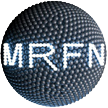The atomic force microscope in this facility can map large areas of the sample surface both by contact AFM and by optical microscopy. This is accomplished with the ThermoMicroscopes M5 microscope. The optical mapping capability is useful for establishing real space maps of grain boundary positions. By combining these images with OIM data, we are able to construct the high resolution orientation maps needed to measure the five parameter grain boundary distribution. The M5 also features programmable stage motion for automated data collection via AFM.


